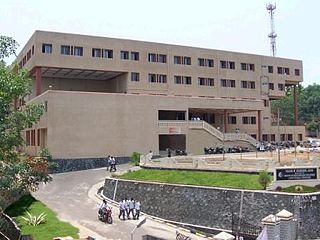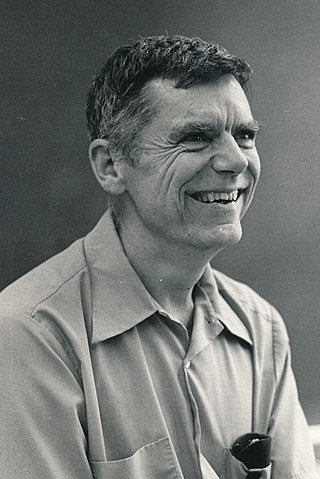
The American National Standards Institute is a private nonprofit organization that oversees the development of voluntary consensus standards for products, services, processes, systems, and personnel in the United States. The organization also coordinates U.S. standards with international standards so that American products can be used worldwide.

A boiler is a closed vessel in which fluid is heated. The fluid does not necessarily boil. The heated or vaporized fluid exits the boiler for use in various processes or heating applications, including water heating, central heating, boiler-based power generation, cooking, and sanitation.

A pressure vessel is a container designed to hold gases or liquids at a pressure substantially different from the ambient pressure.

A boilermaker is a tradesperson who fabricates steels, iron, or copper into boilers and other large containers intended to hold hot gas or liquid, as well as maintains and repairs boilers and boiler systems.

Robert Henry Thurston was an American engineer, and the first Professor of Mechanical Engineering at Stevens Institute of Technology.
Welder certification, is a process which examines and documents a welder's capability to create welds of acceptable quality following a well defined welding procedure.
Engineering ethics is the field of system of moral principles that apply to the practice of engineering. The field examines and sets the obligations by engineers to society, to their clients, and to the profession. As a scholarly discipline, it is closely related to subjects such as the philosophy of science, the philosophy of engineering, and the ethics of technology.
Raymond David Mindlin was an American mechanical engineer, Professor of Applied Science at Columbia University, and recipient of the 1946 Presidential Medal for Merit and many other awards and honours. He is known as mechanician, who made seminal contributions to many branches of applied mechanics, applied physics, and engineering sciences.

The Government College of Engineering, Adoor (CEA) is a college in Adoor, Pathanamthitta District, Kerala, India, located 3 km from the town centre at Manakala. It is affiliated with the APJ Abdul Kalam Technological University and is run under the aegis of the Institute of Human Resources Development, an institute of the government of Kerala. The College was inaugurated in 1995 by the Chief Minister of Kerala A K Antony. College of Engineering Adoor is recognized by the All India Council for Technical Education (AICTE). Recently the college has been selected in Technical Education Quality Improvement Programme (TEQIP) Phase II. It is one of the major engineering colleges in Pathanamthitta District and is one of the eight engineering colleges in the District.

The American Welding Society (AWS) was founded in 1919 as a non-profit organization to advance the science, technology and application of welding and allied joining and cutting processes, including brazing, soldering and thermal spraying.

A Welding Procedure Specification (WPS) is a formal document describing welding procedures. It is an internal document used by welding companies to instruct welders on how to achieve quality production welds that meet all relevant code requirements. Each company typically develops their own WPS for each material alloy and for each welding type used. Specific codes and/or engineering societies are often the driving force behind the development of a company's WPS. A WPS is supported by a Procedure Qualification Record, a formal record of a test weld performed and rigorously tested to ensure that the procedure will produce a good weld. Individual welders are certified with a qualification test documented in a Welder Qualification Test Record (WQTR) that shows they have the understanding and demonstrated ability to work within the specified WPS.

Comfort Avery Adams was an American electrical engineer who as a student helped Albert A. Michelson with the Michelson–Morley experiment (1887), which was later viewed as confirming the special relativity theory of Albert Einstein (1905). He was a recipient of the IEEE Edison Medal and AIEE Lamme Medal.
The ASME Boiler & Pressure Vessel Code (BPVC) is an American Society of Mechanical Engineers (ASME) standard that regulates the design and construction of boilers and pressure vessels. The document is written and maintained by volunteers chosen for their technical expertise. The ASME works as an accreditation body and entitles independent third parties to inspect and ensure compliance to the BPVC.

Philip Gibson Hodge Jr. was an American engineer who specialized in mechanics of elastic and plastic behavior of materials. His work resulted in significant advancements in plasticity theory including developments in the method of characteristics, limit-analysis, piecewise linear isotropic plasticity, and nonlinear programming applications. Hodge was the technical editor of American Society of Mechanical Engineers Journal of Applied Mechanics from 1971-1976. From 1984 to 2000 he was the secretary of the U. S. National Committee on Theoretical and Applied Mechanics, its longest serving Secretary. In 1949 he became assistant professor of Mathematics at UCLA, then moved on to become associate professor of applied mechanics at Polytechnic Institute of Brooklyn in 1953, Professor of Mechanics at Illinois Institute of Technology in 1957, and professor of mechanics at the University of Minnesota in 1971, where he remained until he retired in 1991. After retirement he was professor emeritus at the University of Minnesota and visiting professor emeritus at Stanford University.
ASME is a non-profit organization that continues to develop and maintains nearly 600 codes and standards in a wide range of disciplines. Some of which includes the Boiler and Pressure Vessel Code (BPVC), Elevators and Escalators, Piping and Pipelines, Bioprocessing Equipment (BPE), Nuclear Facility Applications (NQA), Process Performance Test Codes (PTC), and Valves, Flanges, Fittings and Gaskets (B16).

David Schenk Jacobus was an American mechanical engineer, head of the Engineering Department of Babcock & Wilcox, inventor and educator, who served as president of the American Society of Mechanical Engineers in the year 1916–17.
Mayo Dyer Hersey was an American engineer, physicist at the National Bureau of Standards and other government agencies, and Professor of Engineering at Brown University. He received the 1957 ASME Medal, and the first Mayo D. Hersey award in 1965.
J. Robert Sims is an American chemical and mechanical engineer, former research engineer at ExxonMobil, and inventor, who served as president of the American Society of Mechanical Engineers for the year 2014–15.
June Ling is a retired American mechanical engineer who worked for many years on standardization at the American Society of Mechanical Engineers (ASME).












